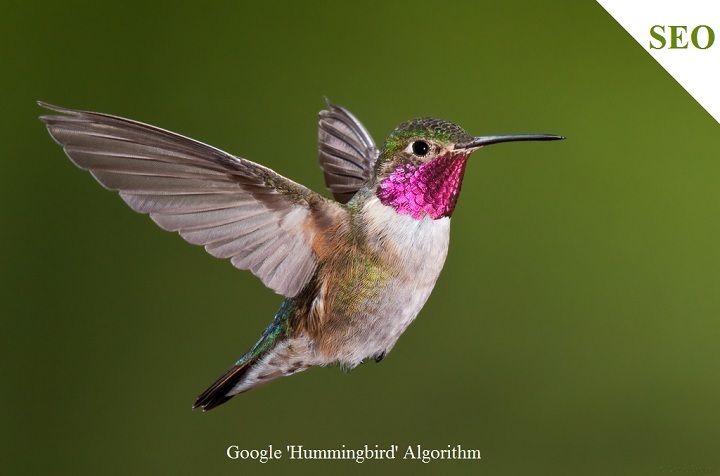When Google released the Panda update, it was a tragedy for many website owners. A couple of weeks ago, Google announced that they will implement a new search algorithm, codename Hummingbird Algorithm. This new algorithm promises to bring a better search results experience, but it is important to analyze the impact that it will have on the ranking of your websites.
The Ranking Algorithm
Those of you not familiar with such SEO terms should know that a ranking algorithm is a method used by Google’s users to determine the results displayed after a search has been performed. This new method of measure will replace the old one. The last two ranking algorithms used by Google are known as Penguin and Panda and they have surely merged with Hummingbird. Behind this new algorithm lies an improvement of conversational search.

Before, when you searched for an entire phrase, you would get results relevant to only some of the words you typed in. For example, if you search for “which Minnesota pizza place makes home delivery” you won’t get results specific to keywords such as “pizza” or “Minnesota” because the algorithm will analyze the entire phrase you typed in. It seems that Google has already implemented this new method for over a month now, so you may not feel the changes starting from this point on.
On-page Optimization Factors
If you’ve had a website up and running for quite some time now, you should know that every major change that affects the search results and user search experience will somehow influence your website as well. The Panda update was so rigorous that it shut down many website that lacked the quality Google is looking to provide for search engine users.
The first thing you need to improve in order to make sure your website will not disappear from Google’s search results is to use the keywords in specific places on your website. Many people think that in order to attract visitors, they should focus on their central keywords as much as they can but really, keyword abuse is one mistake that will ban your website from Google. A single website should not target more than 2 keywords or keyphrases, then make the page’s content relevant to those keywords. The title tag of your webpage should also contain your main keywords because it tips off search engines that your website is a relevant result for those keywords. The headline of your webpage should also integrate your main keyword in a natural way. If the page URL contains that as well, you’re one step closer to becoming a very relevant search result. The images on your website can also be given their own titles, which can be related to the central keywords as well.
Each time you post new content on your website, Google sends out these robots which are called “crawlers” or “web-spiders” to analyze the content and index the information. If your website has a sitemap and a smooth flow, Google will index your pages the right way. In order for that to happen, you first need to make sure that your pages have the right keywords that define your business. All the elements used in navigation should be at hand and the design of the website needs to be user-friendly. The speed at which your website and all its pages load is also crucial.
Another mean for you to optimize your website is by including plug-ins that will allow easy social media sharing. If you have a website that includes a number of pictures (like a gift shop or a professional photography studio), Facebook and Pinterest buttons are great means for easily sharing content. Business websites could include Reedit and LinkedIn buttons.
Link Building
If you are not a SEO savvy, you don’t know the importance of building backlinks or are not even sure what they mean. Let’s put it this way: when you need to plan a wedding, how important is to you when a whole bunch of people recommend this one restaurant? How does the popularity of that restaurant grow in your mind? Backlinks work pretty much the same: the more website connect to your own and recommend it, the more Google considers your website to a valuable source of information for internet users.

There are many cases of link building done the wrong way. Lots of webmasters spammed a lot in order to get backlinks to a specific website. Robots were used to building links using a website’s center keywords as anchor text. But the majority of these links were completely irrelevant to human visitors, so this problem had only one solution: to stop relying on robots and to start thinking like a human. Google would punish website with irrelevant backlinks by dropping their page rankings. This is how the link building strategies were born. However, this sounds easier that it actually is because you need to find good websites to exchange links with.
But before starting with any kind of link building campaign, there are 4 major checklist items that you need to cover. First of all, you need a good and relatively short domain name for your website. The name of your website must not sound like spam, so avoid having a website like www.get-lots-of-cheap-stuff-by-clicking-here.com. Second, remember that no other website would want to link to yours if you are spamming. If you are using any unorthodox SEO methods, stop right now.
The third step requires you to review your website’s content. If you have a virtual shop, you need to add clear pictures and precise descriptions for all the items you’re selling. Last, but not least, there is the design aspect. Remember that whenever you are building a website, you need to make user navigation smooth and comprehensive.
And whenever it all seems too much to handle, remember that Google is the number one search engine in the world and, whether we sometimes dislike it, the content, layout and looks of our website need to please Google if we ever want to get a decent amount of traffic from searches.












![Watch Video Now on xiaohongshu.com [以色列Elevatione perfectio X美容仪 perfectio X 全新仪器黑科技了解下]](https://www.techburgeon.com/wp-content/uploads/2019/07/perfectiox-singapore-150x150.jpg)
